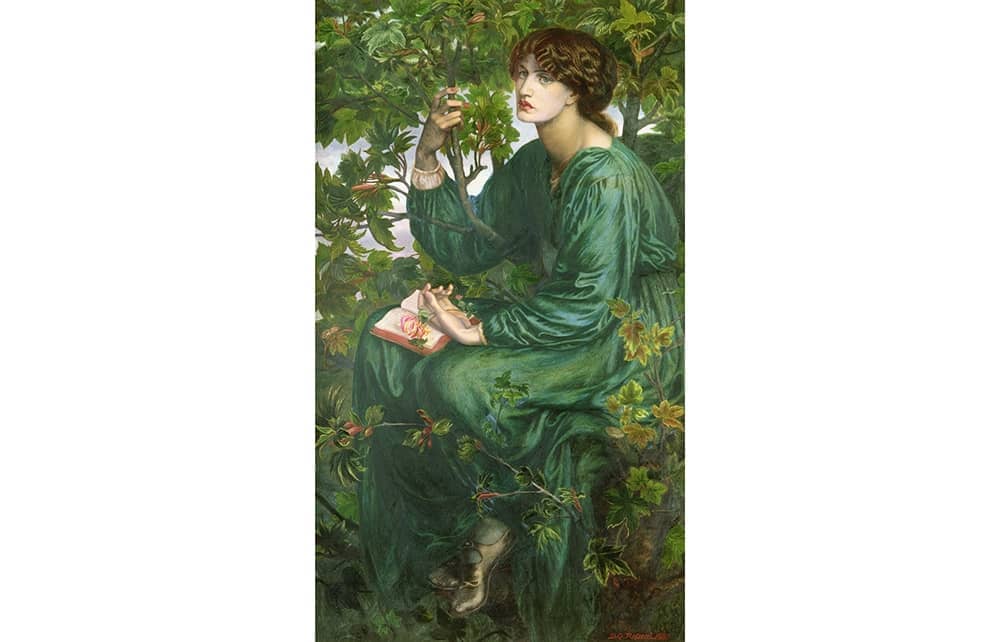William Morris was the son of a stock-broker and Jane Burden was the daughter of a stablehand. He was raised in a mansion in Walthamstow (now the William Morris Gallery) and she grew up in a hovel in Oxford. Had she not been talent-spotted by Dante Gabriel Rossetti when she was leaving the theatre one night, Jane would have become a college servant rather than an artist’s muse.
She married Morris when she was 19, after he had reproduced her as ‘La Belle Iseult’, trapped in a room between a window and a bed, and put her through intensive elocution lessons as well as a crash course in music, art and literature. No trace of her former accent could be heard when she vowed to honour and obey him, and she carried herself from that day forward with the grandeur of a great queen. She was never in love with her husband, she later confessed to the poet and philanderer Wilfrid Scawen Blunt, with whom she had an affair in her middle years. Blunt himself was drawn to Jane because she had also been the mistress of his hero Rossetti – and Rossetti had pursued her because he liked cuckolding his friends.
Suzanne Fagence Cooper’s aim in this joint biography is to demystify Jane Morris, give her a voice and a flesh-and-blood presence and show that William married her because he saw her ‘potential as an equal partner in his plans to make art and poetry’. What becomes clear, however, is that Morris considered no one his equal, least of all a woman. It seems more likely that he married her because, as he famously said, our homes should contain only those things that we ‘know to be useful or believe to be beautiful’ – and Jane was both of these. As her husband’s design company evolved, she embroidered his tapestries, intrigued his friends and represented to perfection the brand of Morris & Co.
William was famous for his rages – and Jane’s 30 years of infidelity can’t have eased the tension
Cooper’s focus is on the couple’s various homes, which she sees as collaborations: Red House in Bexley Heath, where they began their married life; Queen Square in Bloomsbury, where they lived above the firm; Kelmscott Manor in Oxfordshire, whose lease they shared with Rossetti; and Kelmscott House, by the Thames in Hammersmith. ‘Medieval in spirit’, as Morris put it, with giant furniture, bare floors and murals from the Arthurian legends, each house was designed to be a refuge from the modern world.
As experiments in healthy living, they largely failed. Despite the jolly weekends enjoyed with the Pre-Raphaelite Brotherhood, the domestic life of the Morrises was not all fun and games. Their eldest daughter, Jenny, was seriously ill with epilepsy, a condition which could not be discussed; Jane’s lover, Rossetti, whose role in the marriage also could not be discussed, was increasingly addicted to chloral; and Morris himself was addicted to work. While he designed wallpaper, textiles, stained-glass windows and furniture, wrote poetry and novels, translated Icelandic sagas and founded the Society for the Protection of Ancient Buildings, the Socialist League and the Kelmscott Press, Jane largely sewed and made jam. Her recipes, included in the book, are the closest we get to the hands-on homemaker the author is wanting to recreate.
An art historian, Cooper is on solid ground when she writes about the objects, but less so when it comes to human character or emotional complexity, neither of which she can read. On the one hand, she says that Morris’s coldness ‘created a miserable emptiness in the marriage’; on the other, she returns to ‘the continued care that sustained Jane and William’s relationship’.
She describes the marriage as ‘gentle’, although it is not clear what she means by this. Morris was famous for his outbursts of rage, known as ‘berserkers’, which suggests that his presence was threatening; and Jane’s 30 years of infidelity can’t have eased the tension. Because we know next to nothing about the emotional makeup of William or the inner world of Jane, and there are no records of what the couple were like in private, Cooper proceeds largely by guesswork, prodding away at the evidence, interrogating the silences, asking all the right questions and coming up, in my view, with all the wrong answers.
Her sources for her reassessment of Jane are the observations of other people, which she dismisses when they don’t fit her thesis. Everyone who knew Jane described her as preternaturally silent – George Bernard Shaw said she was ‘the silentest woman I have ever met’. But this, Cooper insists, can’t be right. Jane was not silent but ‘silenced’; her quietness in public was due to being unable to get a word in edgeways, and evidence of the ‘difficulties of carrying on personal, homely conversations in the semi-public space of their drawing room’. Henry James, who pictured Jane in a letter to his sister as lying on the sofa, ‘a dark, silent, medieval woman with her medieval toothache’, is chastised for ‘refusing to acknowledge her pain’, after which Cooper accuses him of being excessively concerned with the ‘body beneath her gown’– which must be the first time that James, who had no sexual interest whatever in women, has been charged with prurience.
If anyone is not listening to Jane Morris it is Cooper, who refutes the only direct statement that her subject is known to have made about herself: that she never loved her husband. That’s as may be, Cooper argues; but their life was filled with things that were ‘also love’, such as ‘attachment to the homes they made together’. Few people would agree that shared attachment to a house is a replacement for marital love.
Other interpretations of Jane similarly strain credibility, such as when Cooper seizes on her enjoyment of a baby playing with her hair as ‘overturning all notions of Jane the Goddess’, and describes the medieval garb she dressed up in as an example of Jane’s ‘self-fashioning’. Was Jane inventing her own identity or expressing the Pre-Raphaelite aesthetic?
Interpretations aside, the most striking oddity in these pages is that, apart from the black-and-white images that preface each chapter, there are no illustrations. How We Might Live is effectively an art book without the art. Almost every paragraph contains a description of a tapestry, a dress, a colour, a painting, a photograph, a caricature or the intricacies of a pattern, but the reader has nothing to refer to. Which is ironic in a book about a woman who has been painted out of the picture.






Comments